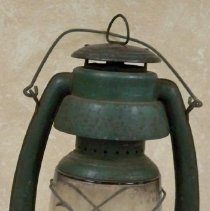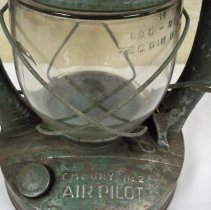Object Record
Images


Metadata
Object Name |
Lantern |
Caption |
Lantern |
Description |
Embury No. 2 Air Pilot lantern. Embury Mfg. Co., Warsaw, NY, USA. Tall metal general purpose lantern; painted green; clear globe; bail handle. Owned by donor Ernest Freitag's grandfather, Carl Freitag, Acoma Township. Air Pilot lanterns were made between c.1936-1953. It is a "Cold Flame Design" which is twice as bright as Hot Flame Designs. These lanterns were made of tin, but in WWII shortages of tin made them use " Terne " plated steel which needed to be painted to last outdoors. William Embury (1873-1943), the founder of Embury Lantern Company, was born in Canada. He worked for several tin manufacturers, one of which produced a small line of lanterns. As a salesman for this company, he noticed that there were several things you could do to make the lanterns easier to use and more efficient and decided to form his own company Defiance Stamping and Lantern Company. The company grew quickly and in 1908 Embury started another company in the Rochester area: the Embury Lantern Company. In 1910, Warsaw, NY was undergoing an economic downturn with empty factory buildings and unemployed workers. The Board of Trade was able to entice Embury to relocate his business to Warsaw, with the Warsaw Improvement Company agreeing to erect a building that would meet his specifications. Embury opted to hire Warsaw residents who needed jobs. His first lines were the Camlox, Windsor, Midget and Duplex, lanterns which sold well. Early automobiles didn’t come with headlights, and the Duplex was sold for automotive use. During 1917-1918, Embury came out with the Supreme line, the first to use a numbering system to indicate design differences. These lanterns could be painted in the purchaser’s color or left in natural tin, and were an immediate success, remaining popular for 20 years. By 1922 Embury introduced electric lanterns, considered part of the Supreme line, which ran on three D cells. These small lanterns were also called conductor lanterns. Railroad conductors preferred them because they didn’t have to worry about spilling fuel or getting soot on their uniforms. It was also called the skater’s lantern because it was much easier and safer to carry when ice skating. Another electric lantern was called Supreme 200, or flashlight, along with a larger 300 model. The electrics were not too successful, so in 1932 the line was sold to the Eveready Company. In 1936, William turned the business over to his three sons, Philip, William and Frederick, who realized they needed a new design, and the result was the Air Pilot, a general purpose lantern produced up to 1953. This was also the period when they started private labeling for various companies. During World War II, the Navy contracted Embury to develop an emergency light in case a ship lost its electrical power. By the end of WW II, demand for lanterns was diminishing, mainly due to the Rural Electrification Act passed under President Franklin D. Roosevelt. Although Embury had become one of the largest lantern companies, second only to Dietz, in 1952 negotiations were started with rival Dietz for Dietz to purchase the company, and by 1953 the era of Warsaw’s Embury Lantern Company ended. |
Catalog Number |
1988-1473-001 |
Search Terms |
Lanterns Freitag Family |
Subjects |
Lanterns |
People |
Freitag, Carl |
